Investment Plan Report: Bluefin Europe LLP in the Financial Sector
VerifiedAdded on 2020/07/22
|14
|3362
|119
Report
AI Summary
This report presents an investment plan analysis for Bluefin Europe LLP, a London-based market-making company specializing in ETFs. The report begins with an introduction and proceeds to analyze the global economy and the UK financial sector, highlighting its contribution to the UK GDP and the potential impacts of Brexit. The company analysis section delves into Bluefin Europe LLP's financial performance for FY 2016, including key financial results, profitability, and liquidity. The report showcases a strong financial position with high profitability margins and a robust current ratio. The report also discusses the regulatory framework, including the role of the FCA and compliance with UK GAAP. Furthermore, the analysis assesses the impact of Brexit on the company and the financial sector, discussing potential opportunities and challenges. The report concludes with a summary of the key findings and a list of references.

INVESTMENT PLAN 2018
Paraphrase This Document
Need a fresh take? Get an instant paraphrase of this document with our AI Paraphraser

Table of Contents
INTRODUCTION...........................................................................................................................1
GLOBAL ECONOMY....................................................................................................................1
INDUSTRY ANALYSIS................................................................................................................2
COMPANY ANALYSIS.................................................................................................................3
Key financial results for FY 2016................................................................................................3
Profitability performance.............................................................................................................4
Liquidity performance..................................................................................................................5
Impact of Brexit on Bluefine Europe LLP...................................................................................7
CONCLUSION..............................................................................................................................10
REFERENCES..............................................................................................................................11
INTRODUCTION...........................................................................................................................1
GLOBAL ECONOMY....................................................................................................................1
INDUSTRY ANALYSIS................................................................................................................2
COMPANY ANALYSIS.................................................................................................................3
Key financial results for FY 2016................................................................................................3
Profitability performance.............................................................................................................4
Liquidity performance..................................................................................................................5
Impact of Brexit on Bluefine Europe LLP...................................................................................7
CONCLUSION..............................................................................................................................10
REFERENCES..............................................................................................................................11

INTRODUCTION
In globalized economy, investors make rationalized investment with the target to gain
maximum return. Bluefin Europe LLP is a London based market making company with
specialization in Exchange Traded Funds (ETFs) and offer liquidity and block trading facilities
for Bonds, emerging markets and commodity ETFs. It operates in financial sector and registered
office situated in London. The investment proposal aims at critically examining the company in
the context of global economy and the industry contribution to the UK economy. It will analyze
economic trends, governmental rules and regulations that company needs to follow. Besides this,
company analysis section covers key attention on its profitability, turnover and its prospective
outlook.
GLOBAL ECONOMY
Global financial sector- It is a global framework of legal agreements, institutions, and
possess both economic factors that is formal and informal. For the purpose of investment and
trade financing them together, facilitate international flows of financial capital. In the last 5 years
the global financial sectors has underperformed the global equity market. The slow economic
growth, low or negative interests rates etc. are been faced by this sector. In the international trade
and investment world migration and communication technology facilitate unprecedented growth.
Towards the greater stability, the global financial system is edging, with different regional or
national needs the government need to deal.
Considering the worldwide importance of the financial sector, it becomes clear that
financial service providers plays an inevitable role in the economy and contributes a significant
percentage to the economic growth. Referring UK, Bluefin Europe LLP is one of the leading
establishments at the domestic marketplace who is engaged in B2B services through providing
priorietary trading facilities at exchange futures and exchange traded funds. Proprietary trading
functions including trading key securities such as bonds, currencies, commodities and other
financial instruments with the firm’s money. It is regulated by the FCA (Financial conduct
Authority) & FSA (Financial Service Authority).
1 | P a g e
In globalized economy, investors make rationalized investment with the target to gain
maximum return. Bluefin Europe LLP is a London based market making company with
specialization in Exchange Traded Funds (ETFs) and offer liquidity and block trading facilities
for Bonds, emerging markets and commodity ETFs. It operates in financial sector and registered
office situated in London. The investment proposal aims at critically examining the company in
the context of global economy and the industry contribution to the UK economy. It will analyze
economic trends, governmental rules and regulations that company needs to follow. Besides this,
company analysis section covers key attention on its profitability, turnover and its prospective
outlook.
GLOBAL ECONOMY
Global financial sector- It is a global framework of legal agreements, institutions, and
possess both economic factors that is formal and informal. For the purpose of investment and
trade financing them together, facilitate international flows of financial capital. In the last 5 years
the global financial sectors has underperformed the global equity market. The slow economic
growth, low or negative interests rates etc. are been faced by this sector. In the international trade
and investment world migration and communication technology facilitate unprecedented growth.
Towards the greater stability, the global financial system is edging, with different regional or
national needs the government need to deal.
Considering the worldwide importance of the financial sector, it becomes clear that
financial service providers plays an inevitable role in the economy and contributes a significant
percentage to the economic growth. Referring UK, Bluefin Europe LLP is one of the leading
establishments at the domestic marketplace who is engaged in B2B services through providing
priorietary trading facilities at exchange futures and exchange traded funds. Proprietary trading
functions including trading key securities such as bonds, currencies, commodities and other
financial instruments with the firm’s money. It is regulated by the FCA (Financial conduct
Authority) & FSA (Financial Service Authority).
1 | P a g e
⊘ This is a preview!⊘
Do you want full access?
Subscribe today to unlock all pages.

Trusted by 1+ million students worldwide
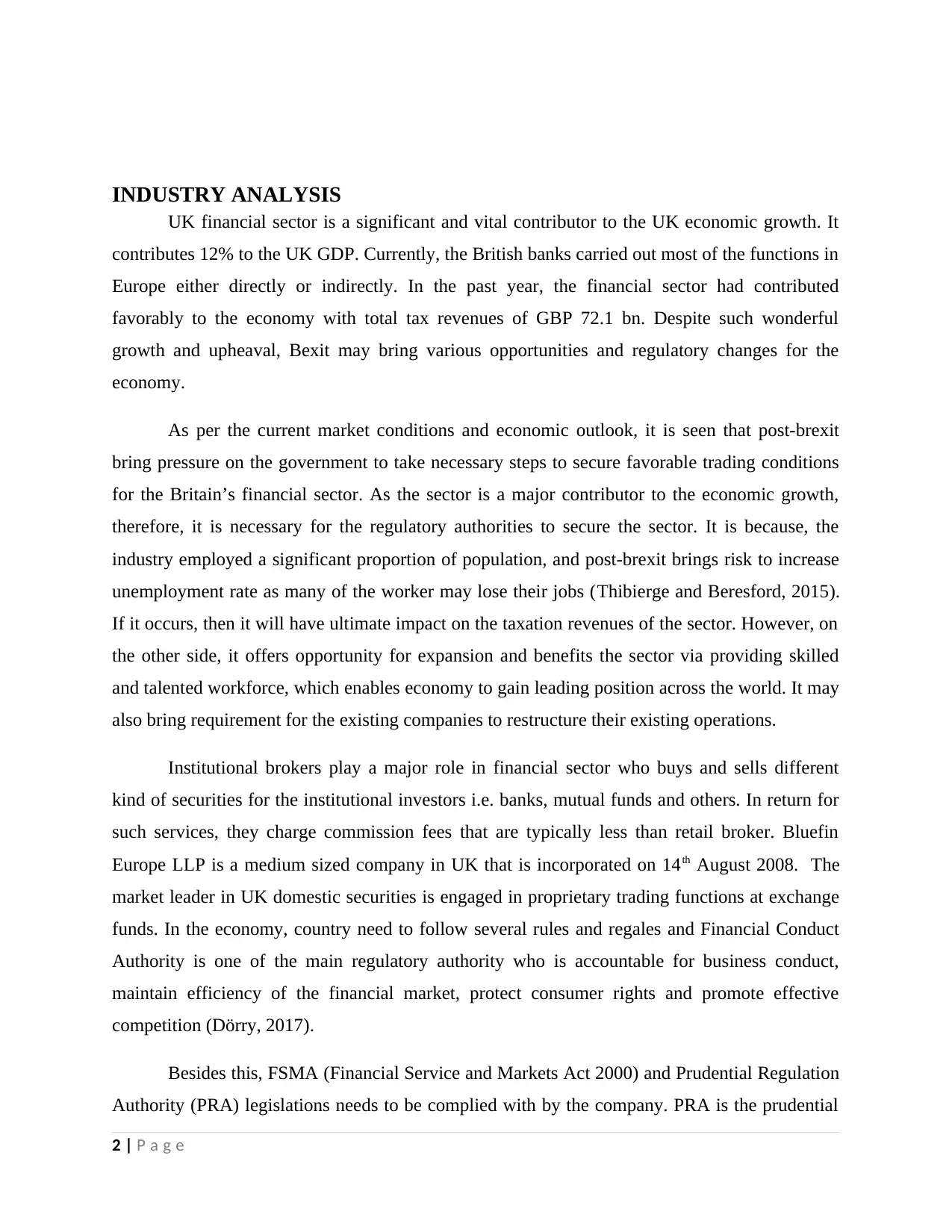
INDUSTRY ANALYSIS
UK financial sector is a significant and vital contributor to the UK economic growth. It
contributes 12% to the UK GDP. Currently, the British banks carried out most of the functions in
Europe either directly or indirectly. In the past year, the financial sector had contributed
favorably to the economy with total tax revenues of GBP 72.1 bn. Despite such wonderful
growth and upheaval, Bexit may bring various opportunities and regulatory changes for the
economy.
As per the current market conditions and economic outlook, it is seen that post-brexit
bring pressure on the government to take necessary steps to secure favorable trading conditions
for the Britain’s financial sector. As the sector is a major contributor to the economic growth,
therefore, it is necessary for the regulatory authorities to secure the sector. It is because, the
industry employed a significant proportion of population, and post-brexit brings risk to increase
unemployment rate as many of the worker may lose their jobs (Thibierge and Beresford, 2015).
If it occurs, then it will have ultimate impact on the taxation revenues of the sector. However, on
the other side, it offers opportunity for expansion and benefits the sector via providing skilled
and talented workforce, which enables economy to gain leading position across the world. It may
also bring requirement for the existing companies to restructure their existing operations.
Institutional brokers play a major role in financial sector who buys and sells different
kind of securities for the institutional investors i.e. banks, mutual funds and others. In return for
such services, they charge commission fees that are typically less than retail broker. Bluefin
Europe LLP is a medium sized company in UK that is incorporated on 14th August 2008. The
market leader in UK domestic securities is engaged in proprietary trading functions at exchange
funds. In the economy, country need to follow several rules and regales and Financial Conduct
Authority is one of the main regulatory authority who is accountable for business conduct,
maintain efficiency of the financial market, protect consumer rights and promote effective
competition (Dörry, 2017).
Besides this, FSMA (Financial Service and Markets Act 2000) and Prudential Regulation
Authority (PRA) legislations needs to be complied with by the company. PRA is the prudential
2 | P a g e
UK financial sector is a significant and vital contributor to the UK economic growth. It
contributes 12% to the UK GDP. Currently, the British banks carried out most of the functions in
Europe either directly or indirectly. In the past year, the financial sector had contributed
favorably to the economy with total tax revenues of GBP 72.1 bn. Despite such wonderful
growth and upheaval, Bexit may bring various opportunities and regulatory changes for the
economy.
As per the current market conditions and economic outlook, it is seen that post-brexit
bring pressure on the government to take necessary steps to secure favorable trading conditions
for the Britain’s financial sector. As the sector is a major contributor to the economic growth,
therefore, it is necessary for the regulatory authorities to secure the sector. It is because, the
industry employed a significant proportion of population, and post-brexit brings risk to increase
unemployment rate as many of the worker may lose their jobs (Thibierge and Beresford, 2015).
If it occurs, then it will have ultimate impact on the taxation revenues of the sector. However, on
the other side, it offers opportunity for expansion and benefits the sector via providing skilled
and talented workforce, which enables economy to gain leading position across the world. It may
also bring requirement for the existing companies to restructure their existing operations.
Institutional brokers play a major role in financial sector who buys and sells different
kind of securities for the institutional investors i.e. banks, mutual funds and others. In return for
such services, they charge commission fees that are typically less than retail broker. Bluefin
Europe LLP is a medium sized company in UK that is incorporated on 14th August 2008. The
market leader in UK domestic securities is engaged in proprietary trading functions at exchange
funds. In the economy, country need to follow several rules and regales and Financial Conduct
Authority is one of the main regulatory authority who is accountable for business conduct,
maintain efficiency of the financial market, protect consumer rights and promote effective
competition (Dörry, 2017).
Besides this, FSMA (Financial Service and Markets Act 2000) and Prudential Regulation
Authority (PRA) legislations needs to be complied with by the company. PRA is the prudential
2 | P a g e
Paraphrase This Document
Need a fresh take? Get an instant paraphrase of this document with our AI Paraphraser
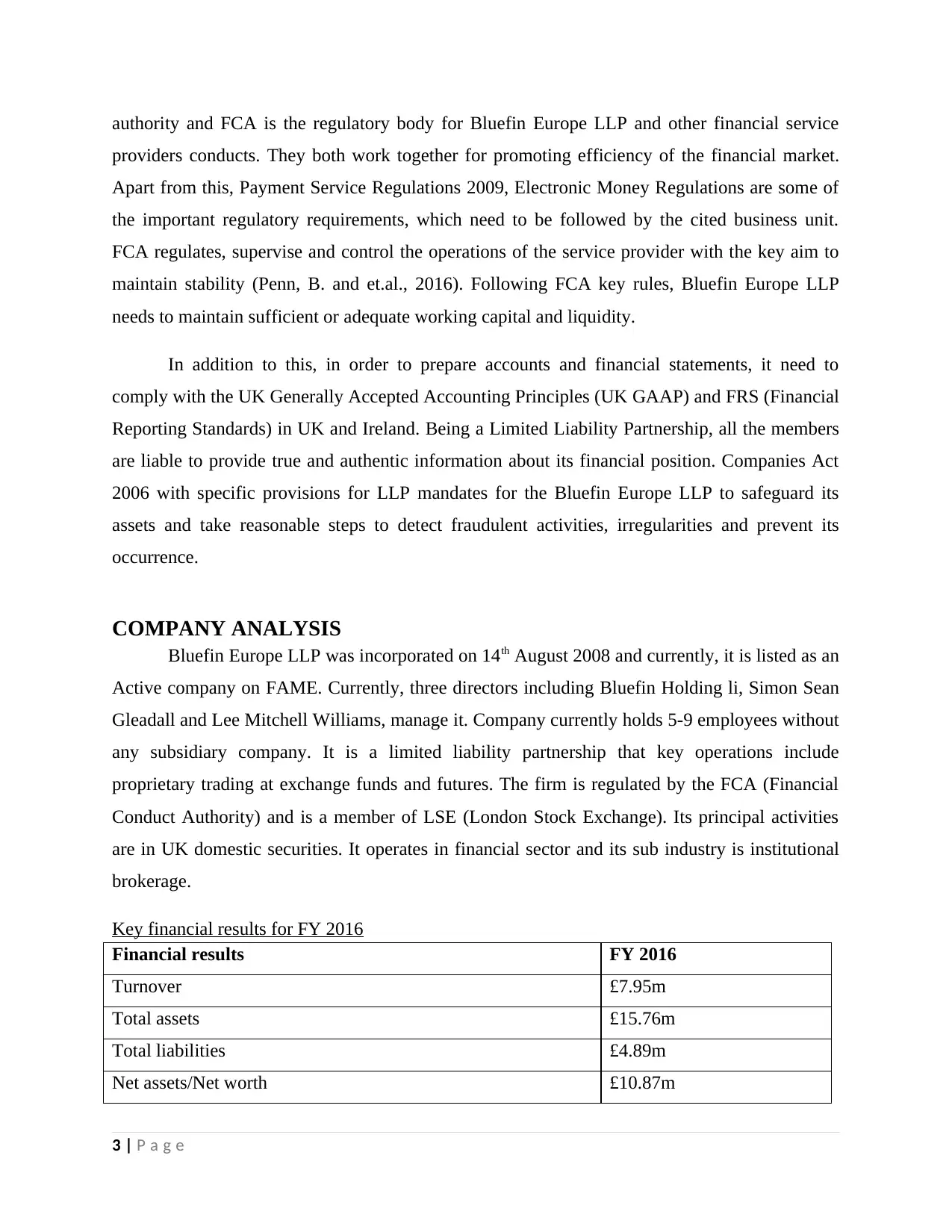
authority and FCA is the regulatory body for Bluefin Europe LLP and other financial service
providers conducts. They both work together for promoting efficiency of the financial market.
Apart from this, Payment Service Regulations 2009, Electronic Money Regulations are some of
the important regulatory requirements, which need to be followed by the cited business unit.
FCA regulates, supervise and control the operations of the service provider with the key aim to
maintain stability (Penn, B. and et.al., 2016). Following FCA key rules, Bluefin Europe LLP
needs to maintain sufficient or adequate working capital and liquidity.
In addition to this, in order to prepare accounts and financial statements, it need to
comply with the UK Generally Accepted Accounting Principles (UK GAAP) and FRS (Financial
Reporting Standards) in UK and Ireland. Being a Limited Liability Partnership, all the members
are liable to provide true and authentic information about its financial position. Companies Act
2006 with specific provisions for LLP mandates for the Bluefin Europe LLP to safeguard its
assets and take reasonable steps to detect fraudulent activities, irregularities and prevent its
occurrence.
COMPANY ANALYSIS
Bluefin Europe LLP was incorporated on 14th August 2008 and currently, it is listed as an
Active company on FAME. Currently, three directors including Bluefin Holding li, Simon Sean
Gleadall and Lee Mitchell Williams, manage it. Company currently holds 5-9 employees without
any subsidiary company. It is a limited liability partnership that key operations include
proprietary trading at exchange funds and futures. The firm is regulated by the FCA (Financial
Conduct Authority) and is a member of LSE (London Stock Exchange). Its principal activities
are in UK domestic securities. It operates in financial sector and its sub industry is institutional
brokerage.
Key financial results for FY 2016
Financial results FY 2016
Turnover £7.95m
Total assets £15.76m
Total liabilities £4.89m
Net assets/Net worth £10.87m
3 | P a g e
providers conducts. They both work together for promoting efficiency of the financial market.
Apart from this, Payment Service Regulations 2009, Electronic Money Regulations are some of
the important regulatory requirements, which need to be followed by the cited business unit.
FCA regulates, supervise and control the operations of the service provider with the key aim to
maintain stability (Penn, B. and et.al., 2016). Following FCA key rules, Bluefin Europe LLP
needs to maintain sufficient or adequate working capital and liquidity.
In addition to this, in order to prepare accounts and financial statements, it need to
comply with the UK Generally Accepted Accounting Principles (UK GAAP) and FRS (Financial
Reporting Standards) in UK and Ireland. Being a Limited Liability Partnership, all the members
are liable to provide true and authentic information about its financial position. Companies Act
2006 with specific provisions for LLP mandates for the Bluefin Europe LLP to safeguard its
assets and take reasonable steps to detect fraudulent activities, irregularities and prevent its
occurrence.
COMPANY ANALYSIS
Bluefin Europe LLP was incorporated on 14th August 2008 and currently, it is listed as an
Active company on FAME. Currently, three directors including Bluefin Holding li, Simon Sean
Gleadall and Lee Mitchell Williams, manage it. Company currently holds 5-9 employees without
any subsidiary company. It is a limited liability partnership that key operations include
proprietary trading at exchange funds and futures. The firm is regulated by the FCA (Financial
Conduct Authority) and is a member of LSE (London Stock Exchange). Its principal activities
are in UK domestic securities. It operates in financial sector and its sub industry is institutional
brokerage.
Key financial results for FY 2016
Financial results FY 2016
Turnover £7.95m
Total assets £15.76m
Total liabilities £4.89m
Net assets/Net worth £10.87m
3 | P a g e
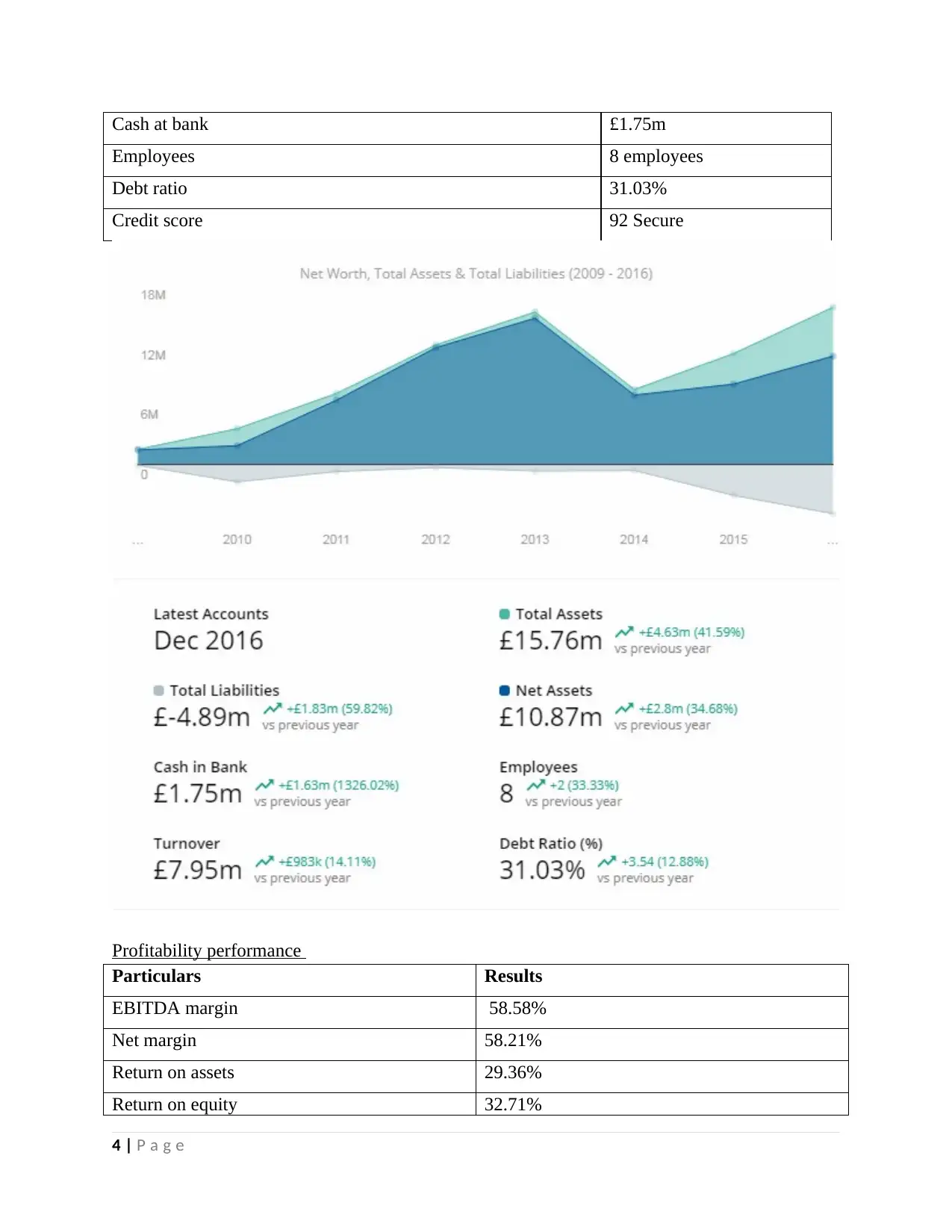
Cash at bank £1.75m
Employees 8 employees
Debt ratio 31.03%
Credit score 92 Secure
Profitability performance
Particulars Results
EBITDA margin 58.58%
Net margin 58.21%
Return on assets 29.36%
Return on equity 32.71%
4 | P a g e
Employees 8 employees
Debt ratio 31.03%
Credit score 92 Secure
Profitability performance
Particulars Results
EBITDA margin 58.58%
Net margin 58.21%
Return on assets 29.36%
Return on equity 32.71%
4 | P a g e
⊘ This is a preview!⊘
Do you want full access?
Subscribe today to unlock all pages.

Trusted by 1+ million students worldwide
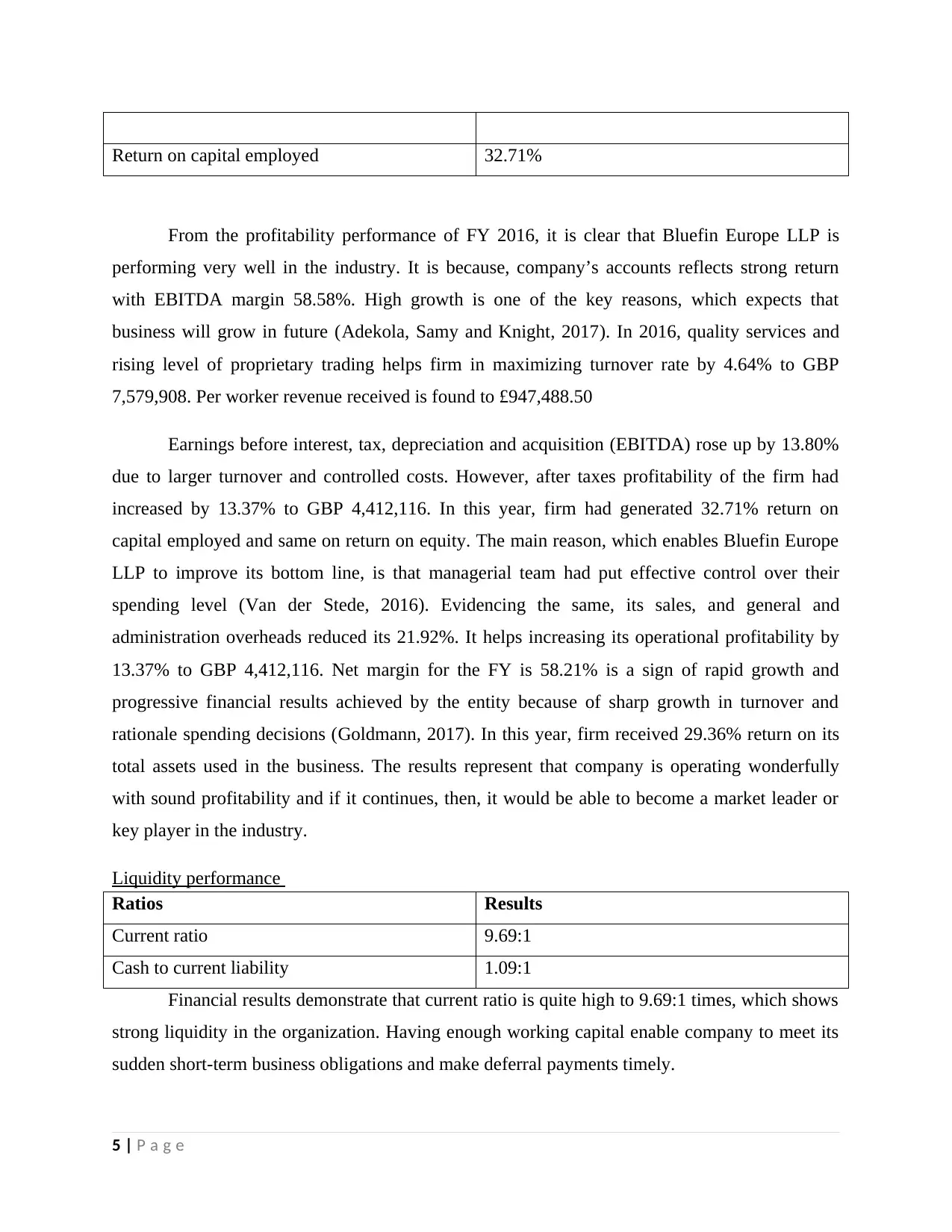
Return on capital employed 32.71%
From the profitability performance of FY 2016, it is clear that Bluefin Europe LLP is
performing very well in the industry. It is because, company’s accounts reflects strong return
with EBITDA margin 58.58%. High growth is one of the key reasons, which expects that
business will grow in future (Adekola, Samy and Knight, 2017). In 2016, quality services and
rising level of proprietary trading helps firm in maximizing turnover rate by 4.64% to GBP
7,579,908. Per worker revenue received is found to £947,488.50
Earnings before interest, tax, depreciation and acquisition (EBITDA) rose up by 13.80%
due to larger turnover and controlled costs. However, after taxes profitability of the firm had
increased by 13.37% to GBP 4,412,116. In this year, firm had generated 32.71% return on
capital employed and same on return on equity. The main reason, which enables Bluefin Europe
LLP to improve its bottom line, is that managerial team had put effective control over their
spending level (Van der Stede, 2016). Evidencing the same, its sales, and general and
administration overheads reduced its 21.92%. It helps increasing its operational profitability by
13.37% to GBP 4,412,116. Net margin for the FY is 58.21% is a sign of rapid growth and
progressive financial results achieved by the entity because of sharp growth in turnover and
rationale spending decisions (Goldmann, 2017). In this year, firm received 29.36% return on its
total assets used in the business. The results represent that company is operating wonderfully
with sound profitability and if it continues, then, it would be able to become a market leader or
key player in the industry.
Liquidity performance
Ratios Results
Current ratio 9.69:1
Cash to current liability 1.09:1
Financial results demonstrate that current ratio is quite high to 9.69:1 times, which shows
strong liquidity in the organization. Having enough working capital enable company to meet its
sudden short-term business obligations and make deferral payments timely.
5 | P a g e
From the profitability performance of FY 2016, it is clear that Bluefin Europe LLP is
performing very well in the industry. It is because, company’s accounts reflects strong return
with EBITDA margin 58.58%. High growth is one of the key reasons, which expects that
business will grow in future (Adekola, Samy and Knight, 2017). In 2016, quality services and
rising level of proprietary trading helps firm in maximizing turnover rate by 4.64% to GBP
7,579,908. Per worker revenue received is found to £947,488.50
Earnings before interest, tax, depreciation and acquisition (EBITDA) rose up by 13.80%
due to larger turnover and controlled costs. However, after taxes profitability of the firm had
increased by 13.37% to GBP 4,412,116. In this year, firm had generated 32.71% return on
capital employed and same on return on equity. The main reason, which enables Bluefin Europe
LLP to improve its bottom line, is that managerial team had put effective control over their
spending level (Van der Stede, 2016). Evidencing the same, its sales, and general and
administration overheads reduced its 21.92%. It helps increasing its operational profitability by
13.37% to GBP 4,412,116. Net margin for the FY is 58.21% is a sign of rapid growth and
progressive financial results achieved by the entity because of sharp growth in turnover and
rationale spending decisions (Goldmann, 2017). In this year, firm received 29.36% return on its
total assets used in the business. The results represent that company is operating wonderfully
with sound profitability and if it continues, then, it would be able to become a market leader or
key player in the industry.
Liquidity performance
Ratios Results
Current ratio 9.69:1
Cash to current liability 1.09:1
Financial results demonstrate that current ratio is quite high to 9.69:1 times, which shows
strong liquidity in the organization. Having enough working capital enable company to meet its
sudden short-term business obligations and make deferral payments timely.
5 | P a g e
Paraphrase This Document
Need a fresh take? Get an instant paraphrase of this document with our AI Paraphraser
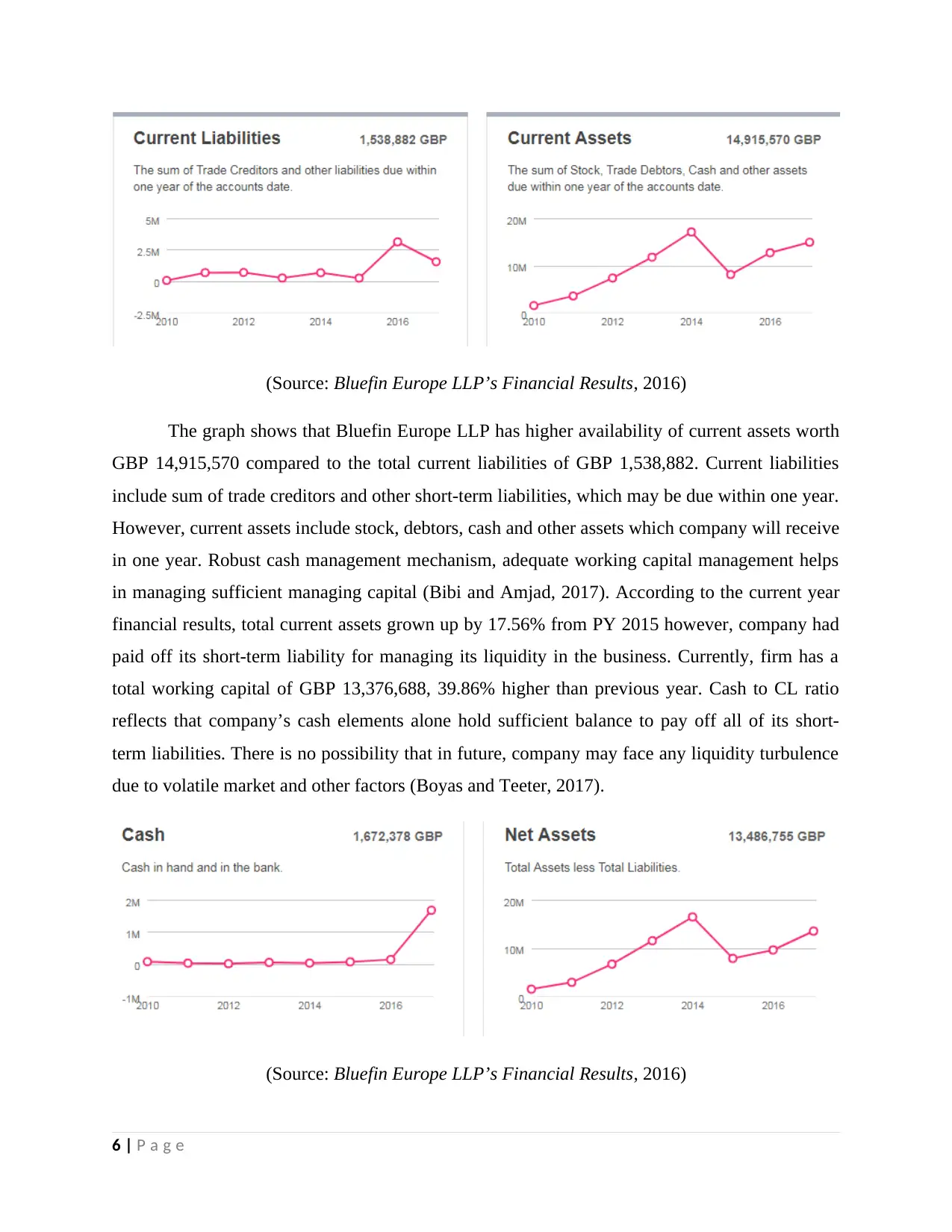
(Source: Bluefin Europe LLP’s Financial Results, 2016)
The graph shows that Bluefin Europe LLP has higher availability of current assets worth
GBP 14,915,570 compared to the total current liabilities of GBP 1,538,882. Current liabilities
include sum of trade creditors and other short-term liabilities, which may be due within one year.
However, current assets include stock, debtors, cash and other assets which company will receive
in one year. Robust cash management mechanism, adequate working capital management helps
in managing sufficient managing capital (Bibi and Amjad, 2017). According to the current year
financial results, total current assets grown up by 17.56% from PY 2015 however, company had
paid off its short-term liability for managing its liquidity in the business. Currently, firm has a
total working capital of GBP 13,376,688, 39.86% higher than previous year. Cash to CL ratio
reflects that company’s cash elements alone hold sufficient balance to pay off all of its short-
term liabilities. There is no possibility that in future, company may face any liquidity turbulence
due to volatile market and other factors (Boyas and Teeter, 2017).
(Source: Bluefin Europe LLP’s Financial Results, 2016)
6 | P a g e
The graph shows that Bluefin Europe LLP has higher availability of current assets worth
GBP 14,915,570 compared to the total current liabilities of GBP 1,538,882. Current liabilities
include sum of trade creditors and other short-term liabilities, which may be due within one year.
However, current assets include stock, debtors, cash and other assets which company will receive
in one year. Robust cash management mechanism, adequate working capital management helps
in managing sufficient managing capital (Bibi and Amjad, 2017). According to the current year
financial results, total current assets grown up by 17.56% from PY 2015 however, company had
paid off its short-term liability for managing its liquidity in the business. Currently, firm has a
total working capital of GBP 13,376,688, 39.86% higher than previous year. Cash to CL ratio
reflects that company’s cash elements alone hold sufficient balance to pay off all of its short-
term liabilities. There is no possibility that in future, company may face any liquidity turbulence
due to volatile market and other factors (Boyas and Teeter, 2017).
(Source: Bluefin Europe LLP’s Financial Results, 2016)
6 | P a g e
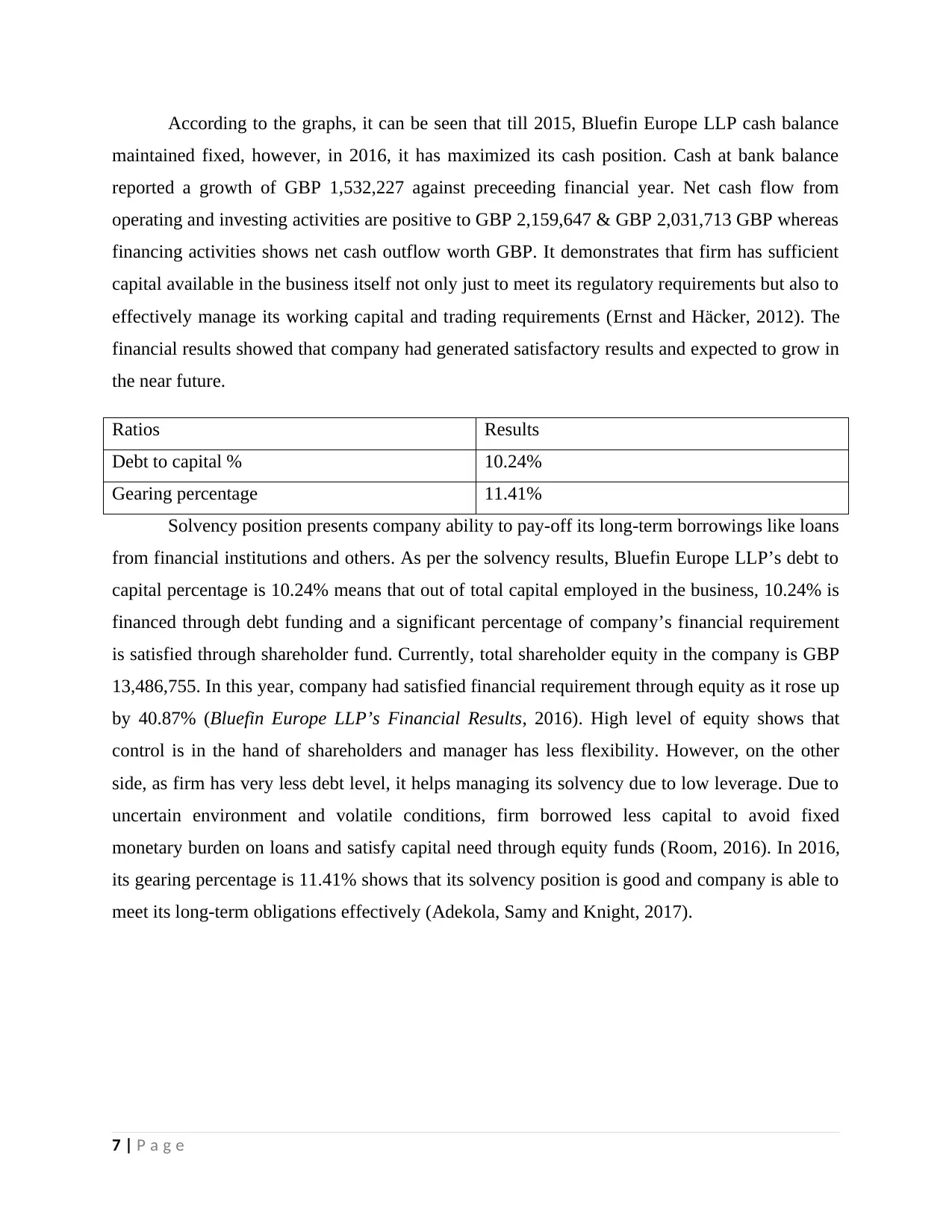
According to the graphs, it can be seen that till 2015, Bluefin Europe LLP cash balance
maintained fixed, however, in 2016, it has maximized its cash position. Cash at bank balance
reported a growth of GBP 1,532,227 against preceeding financial year. Net cash flow from
operating and investing activities are positive to GBP 2,159,647 & GBP 2,031,713 GBP whereas
financing activities shows net cash outflow worth GBP. It demonstrates that firm has sufficient
capital available in the business itself not only just to meet its regulatory requirements but also to
effectively manage its working capital and trading requirements (Ernst and Häcker, 2012). The
financial results showed that company had generated satisfactory results and expected to grow in
the near future.
Ratios Results
Debt to capital % 10.24%
Gearing percentage 11.41%
Solvency position presents company ability to pay-off its long-term borrowings like loans
from financial institutions and others. As per the solvency results, Bluefin Europe LLP’s debt to
capital percentage is 10.24% means that out of total capital employed in the business, 10.24% is
financed through debt funding and a significant percentage of company’s financial requirement
is satisfied through shareholder fund. Currently, total shareholder equity in the company is GBP
13,486,755. In this year, company had satisfied financial requirement through equity as it rose up
by 40.87% (Bluefin Europe LLP’s Financial Results, 2016). High level of equity shows that
control is in the hand of shareholders and manager has less flexibility. However, on the other
side, as firm has very less debt level, it helps managing its solvency due to low leverage. Due to
uncertain environment and volatile conditions, firm borrowed less capital to avoid fixed
monetary burden on loans and satisfy capital need through equity funds (Room, 2016). In 2016,
its gearing percentage is 11.41% shows that its solvency position is good and company is able to
meet its long-term obligations effectively (Adekola, Samy and Knight, 2017).
7 | P a g e
maintained fixed, however, in 2016, it has maximized its cash position. Cash at bank balance
reported a growth of GBP 1,532,227 against preceeding financial year. Net cash flow from
operating and investing activities are positive to GBP 2,159,647 & GBP 2,031,713 GBP whereas
financing activities shows net cash outflow worth GBP. It demonstrates that firm has sufficient
capital available in the business itself not only just to meet its regulatory requirements but also to
effectively manage its working capital and trading requirements (Ernst and Häcker, 2012). The
financial results showed that company had generated satisfactory results and expected to grow in
the near future.
Ratios Results
Debt to capital % 10.24%
Gearing percentage 11.41%
Solvency position presents company ability to pay-off its long-term borrowings like loans
from financial institutions and others. As per the solvency results, Bluefin Europe LLP’s debt to
capital percentage is 10.24% means that out of total capital employed in the business, 10.24% is
financed through debt funding and a significant percentage of company’s financial requirement
is satisfied through shareholder fund. Currently, total shareholder equity in the company is GBP
13,486,755. In this year, company had satisfied financial requirement through equity as it rose up
by 40.87% (Bluefin Europe LLP’s Financial Results, 2016). High level of equity shows that
control is in the hand of shareholders and manager has less flexibility. However, on the other
side, as firm has very less debt level, it helps managing its solvency due to low leverage. Due to
uncertain environment and volatile conditions, firm borrowed less capital to avoid fixed
monetary burden on loans and satisfy capital need through equity funds (Room, 2016). In 2016,
its gearing percentage is 11.41% shows that its solvency position is good and company is able to
meet its long-term obligations effectively (Adekola, Samy and Knight, 2017).
7 | P a g e
⊘ This is a preview!⊘
Do you want full access?
Subscribe today to unlock all pages.

Trusted by 1+ million students worldwide

(Source: Bluefin Europe LLP, 2016)
Above line graph clearly represents that FY 2016 had proven successful for the Bluefin
Europe LLP in which, its net worth, current assets, cash balance shows improvement to GBP
13.5m, GBP 1.7m and GBP 14.9m whereas firm had minimized its current liabilities to the GBP
1.5m to manage its creditworthiness strongly.
Impact of Brexit on Bluefine Europe LLP
Recently, UK separation or departure from the member of European Union will have a
significant impact on the finance service sector. Currently, the Financial Conduct Authority
(FCA), an independent regulatory body, regulates the financing services in UK, which is
financed through charging fees by all members. It regulates all the companies who are offering
financial services to the consumers with the key aim of maintaining integrity in financing
market. After refendum, FCA says that existing financial firms operating in the country such as
Bluefin Europe LLP need to plan and make necessary actions to promote and protect vulnerable
consumers. The authority said that companies would remain strong after Brexit by giving top
priority to the vulnerable customers (Treanor, 2017). Andrew Bailey, FCA’s chief executive
reported that regulatory authorities are working for scrutinizing the sector by transferring various
EU regulations into UK regulatory and legislator system.
8 | P a g e
Above line graph clearly represents that FY 2016 had proven successful for the Bluefin
Europe LLP in which, its net worth, current assets, cash balance shows improvement to GBP
13.5m, GBP 1.7m and GBP 14.9m whereas firm had minimized its current liabilities to the GBP
1.5m to manage its creditworthiness strongly.
Impact of Brexit on Bluefine Europe LLP
Recently, UK separation or departure from the member of European Union will have a
significant impact on the finance service sector. Currently, the Financial Conduct Authority
(FCA), an independent regulatory body, regulates the financing services in UK, which is
financed through charging fees by all members. It regulates all the companies who are offering
financial services to the consumers with the key aim of maintaining integrity in financing
market. After refendum, FCA says that existing financial firms operating in the country such as
Bluefin Europe LLP need to plan and make necessary actions to promote and protect vulnerable
consumers. The authority said that companies would remain strong after Brexit by giving top
priority to the vulnerable customers (Treanor, 2017). Andrew Bailey, FCA’s chief executive
reported that regulatory authorities are working for scrutinizing the sector by transferring various
EU regulations into UK regulatory and legislator system.
8 | P a g e
Paraphrase This Document
Need a fresh take? Get an instant paraphrase of this document with our AI Paraphraser

Brexit would raise uncertainty and bring opportunities for the financial service providers.
Thus, in order to mitigate the same, FCA is working closely with the Bank of England and
Treasury to assure smooth transfer of EU policies and laws into domestic framework. By
maintaining good relationship with the EU regulators, company can manage the sector
successfully (Ferran, 2017). As a result of Brexit, financial service rendering companies need to
prioritize top focus to the key facets including payment protection insurance, scrutinize high cost
credit and protect vulnerable consumers base. Bluefin Europe LLP will be affected with the
brexit as new trading terms and policies may came into force which raise regulatory uncertainty
for the firm. Although existing rules and regulations made by FCA will remain applicable and
still in force, still, coming of new laws may have considerable impact on the business
functioning.
Post-Brexit would require UK to establish a several separate trading arrangements with
the countries across the world, which in turn, it will enable FCA to extend its overseas influence.
It can also bring fundamental structural reform requirements for EU establishments and
preventing them carrying out several key activities like proprietary trading (Armour, 2017).
However, on the other side, as Bluefin Europe LLP operates nationally in UK, thus, departure
from European Union provides opportunity to the company to expand their operations
worldwide. Thus, it offer expansion opportunity by which, it can expand their geographical
presence, increase their level of operations and generates higher sales volume. By this, firm can
improve its bottom line and maximize its competitive position largely. Expanding operations
across different countries of the world enable cited business unit to beat competitors and gain
leading position in the sector (Dhingra and et.al., 2016). With the effect from 10th June 2009, the
entity commence trading as a leader at UK domestic market place. It settled its key operations
and activities via settlement agreement to Merrill Lynch International limited.
9 | P a g e
Thus, in order to mitigate the same, FCA is working closely with the Bank of England and
Treasury to assure smooth transfer of EU policies and laws into domestic framework. By
maintaining good relationship with the EU regulators, company can manage the sector
successfully (Ferran, 2017). As a result of Brexit, financial service rendering companies need to
prioritize top focus to the key facets including payment protection insurance, scrutinize high cost
credit and protect vulnerable consumers base. Bluefin Europe LLP will be affected with the
brexit as new trading terms and policies may came into force which raise regulatory uncertainty
for the firm. Although existing rules and regulations made by FCA will remain applicable and
still in force, still, coming of new laws may have considerable impact on the business
functioning.
Post-Brexit would require UK to establish a several separate trading arrangements with
the countries across the world, which in turn, it will enable FCA to extend its overseas influence.
It can also bring fundamental structural reform requirements for EU establishments and
preventing them carrying out several key activities like proprietary trading (Armour, 2017).
However, on the other side, as Bluefin Europe LLP operates nationally in UK, thus, departure
from European Union provides opportunity to the company to expand their operations
worldwide. Thus, it offer expansion opportunity by which, it can expand their geographical
presence, increase their level of operations and generates higher sales volume. By this, firm can
improve its bottom line and maximize its competitive position largely. Expanding operations
across different countries of the world enable cited business unit to beat competitors and gain
leading position in the sector (Dhingra and et.al., 2016). With the effect from 10th June 2009, the
entity commence trading as a leader at UK domestic market place. It settled its key operations
and activities via settlement agreement to Merrill Lynch International limited.
9 | P a g e
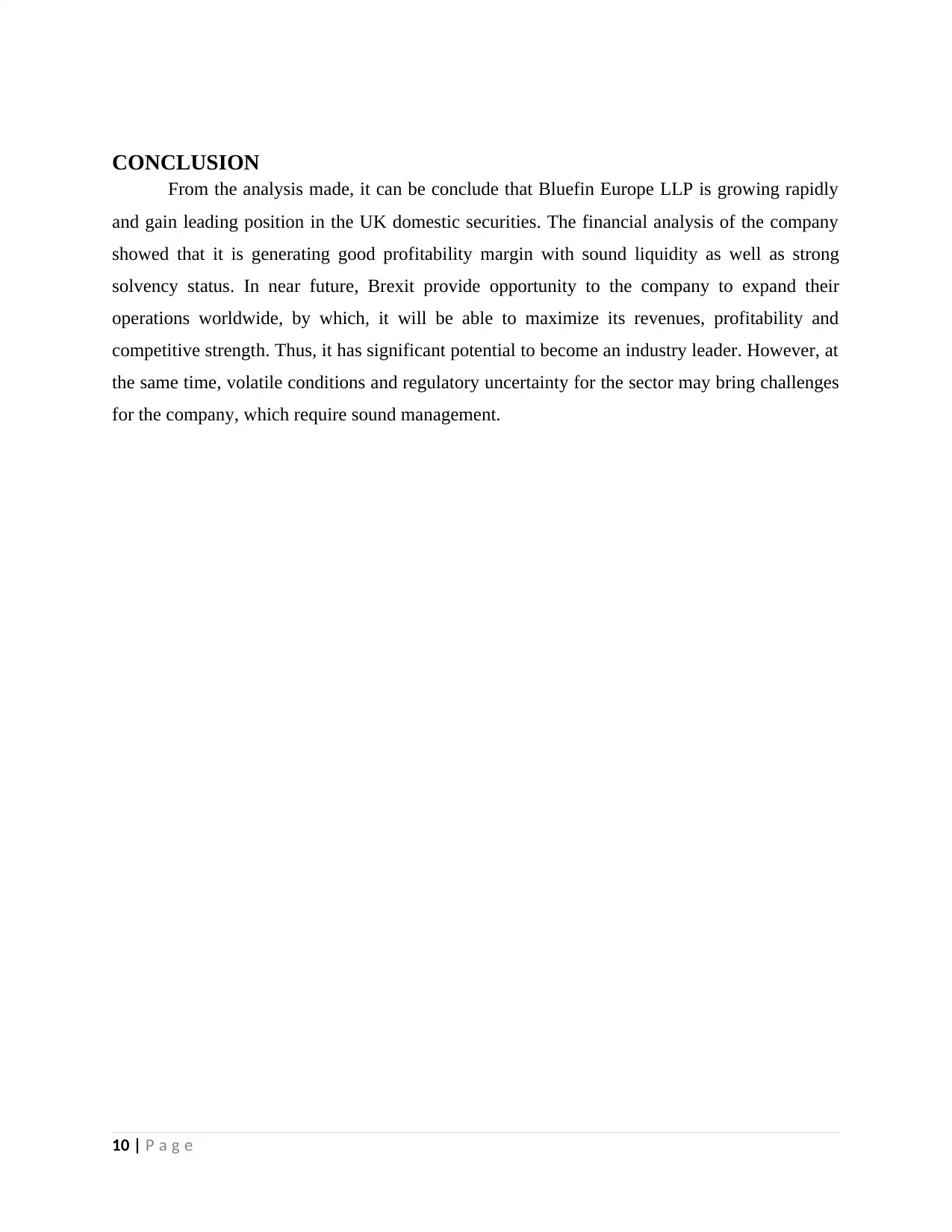
CONCLUSION
From the analysis made, it can be conclude that Bluefin Europe LLP is growing rapidly
and gain leading position in the UK domestic securities. The financial analysis of the company
showed that it is generating good profitability margin with sound liquidity as well as strong
solvency status. In near future, Brexit provide opportunity to the company to expand their
operations worldwide, by which, it will be able to maximize its revenues, profitability and
competitive strength. Thus, it has significant potential to become an industry leader. However, at
the same time, volatile conditions and regulatory uncertainty for the sector may bring challenges
for the company, which require sound management.
10 | P a g e
From the analysis made, it can be conclude that Bluefin Europe LLP is growing rapidly
and gain leading position in the UK domestic securities. The financial analysis of the company
showed that it is generating good profitability margin with sound liquidity as well as strong
solvency status. In near future, Brexit provide opportunity to the company to expand their
operations worldwide, by which, it will be able to maximize its revenues, profitability and
competitive strength. Thus, it has significant potential to become an industry leader. However, at
the same time, volatile conditions and regulatory uncertainty for the sector may bring challenges
for the company, which require sound management.
10 | P a g e
⊘ This is a preview!⊘
Do you want full access?
Subscribe today to unlock all pages.

Trusted by 1+ million students worldwide
1 out of 14
Related Documents
Your All-in-One AI-Powered Toolkit for Academic Success.
+13062052269
info@desklib.com
Available 24*7 on WhatsApp / Email
![[object Object]](/_next/static/media/star-bottom.7253800d.svg)
Unlock your academic potential
Copyright © 2020–2026 A2Z Services. All Rights Reserved. Developed and managed by ZUCOL.





